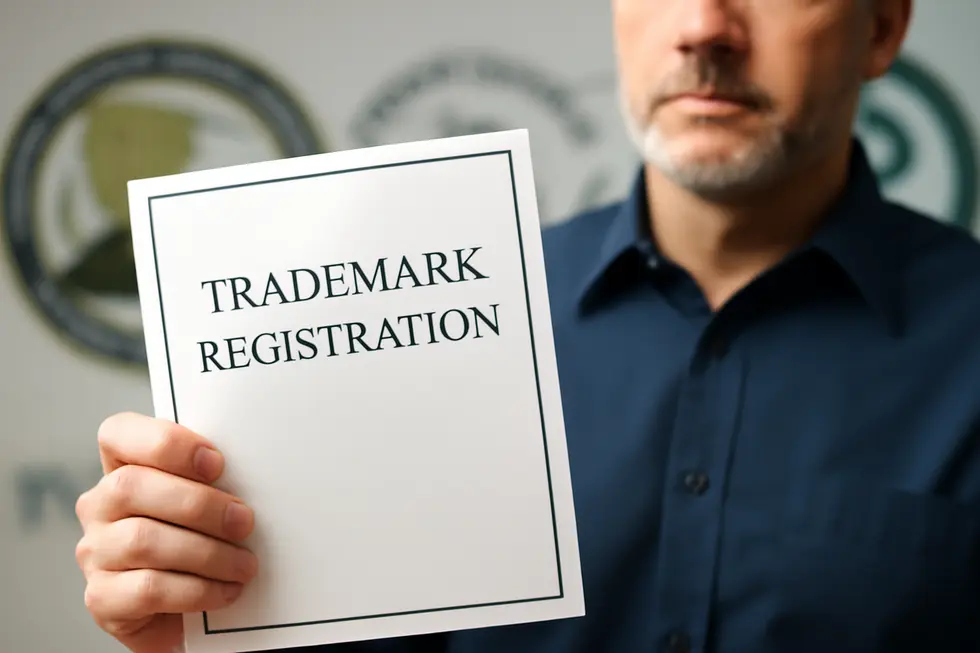Introduction
Securing a unique business name is a vital step for establishing your brand identity and fostering trust with customers. While many business owners seek to “patent” their business name, it’s important to understand that patents do not apply to names or brands. Instead, trademark protection offers the legal foundation to exclusively use and defend your business name in commerce. This guide will walk you through why a business name cannot be patented and the significance of trademarks, how to conduct a thorough name availability search, the essential steps to register and protect your business name, the detailed process of applying for a trademark with the USPTO, and additional strategies to safeguard your brand beyond just legal registration. Each section builds upon the last to equip you with the knowledge needed to confidently protect your business identity across all platforms and legal arenas.
Tables of Contents
Chapter 1: Understanding Why You Cannot Patent a Business Name and the Importance of Trademark Protection
- Why Patents Don’t Apply to Business Names and How Trademarks Secure Your Brand Identity
- The Economic Impact of Trademark Protection: Building Brand Value and Business Growth
- Trademark Registration: The Essential Legal Foundation for Brand Security and International Growth
Chapter 2: How to Conduct a Comprehensive Name Search When Seeking to Patent a Business Name
- Mastering Federal and State Database Searches to Secure Your Business Name
- Decoding Name Search Results: Assessing Risks and Avoiding Conflicts in Business Name Protection
- Leveraging Expert Search Services to Ensure a Thorough and Strategic Business Name Check
Chapter 3: Steps to Register and Protect Your Business Name Instead of Patenting It
- How to Effectively Choose and Verify Your Business Name for Legal Protection
- Navigating Legal Registration and Business Structures to Secure Your Business Name
- Comprehensive Trademark and Digital Asset Strategy to Secure Your Business Name
Chapter 4: Navigating the USPTO Trademark Application Process for Patenting a Business Name
- Mastering the Comprehensive Trademark Search: The Crucial First Step in Securing Your Business Name at the USPTO
- Mastering the Essentials: Accurately Preparing and Filing Your Trademark Application with the USPTO
- Mastering Fee Management and Office Action Responses in the USPTO Trademark Journey
Chapter 5: Additional Considerations in Protecting Your Business Name Beyond Patenting
- The Crucial Role of Trademark Registration and Common Law Rights in Safeguarding Your Business Name
- Comprehensive Digital Asset Safeguards: Strengthening Your Business Name Protection Beyond Patents
- Proactive Vigilance and Enforcement: Sustaining Strong Trademark Protection for Your Business Name
Chapter 1: Understanding Why You Cannot Patent a Business Name and the Importance of Trademark Protection

1. Why Patents Don’t Apply to Business Names and How Trademarks Secure Your Brand Identity
Patents and trademarks serve distinct legal purposes, and understanding this difference is key to protecting a business name. Patents protect inventions or technological innovations that are new, useful, and non-obvious. They grant inventors exclusive rights for about 20 years from the filing date, provided the invention meets strict criteria. Business names, however, do not fall under patent protection because they are not inventions or processes—they are brand identifiers. Instead, trademarks exist precisely to protect these brand elements, including names, logos, slogans, and designs used to distinguish goods or services in commerce.
Trademarks grant indefinite protection as long as the mark remains in use and is properly maintained. Unlike patents, trademarks don’t require an invention or novelty; they rely on actual commercial use to prevent confusion among consumers. This protection helps preserve the unique identity and goodwill associated with a business name by legally preventing others in the same industry from adopting similar identifiers. While trademarks can be enforced without formal registration due to common law rights, registering a trademark with the USPTO significantly strengthens legal standing and nationwide exclusivity.
It’s important to note copyrights protect original creative works like books or music but do not extend to business names or inventions. The business name fits squarely within trademark law, making trademark registration the essential step for entrepreneurs seeking to guard their brand’s identity and market presence. For more about how trademark protection works to secure business names and logos, visit this comprehensive resource on trademark protection for business name and logo.
2. The Economic Impact of Trademark Protection: Building Brand Value and Business Growth
A business name cannot be patented because patents protect inventions or unique technical processes, not identifiers such as names or logos. Instead, trademarks serve as the legal tool to protect a business’s brand identity. Obtaining a registered trademark for your business name provides exclusive rights nationwide, preventing others from using confusingly similar marks that could dilute your brand or cause customer confusion.
Trademark protection plays a vital economic role by establishing clear legal ownership, which is crucial for maintaining a competitive edge. It signals authenticity to customers, often marked by the ® symbol, enhancing trust and credibility. This legal exclusivity supports business expansion, allowing consistent branding across new markets and even international territories. Moreover, trademarks become valuable intellectual property assets that can be licensed or sold, increasing the overall worth of the enterprise.
While registering a company name with state authorities offers official recognition, it does not grant exclusive trademark rights. Without a trademark, others may secure rights to the same or similar names in commerce, putting your brand and market position at risk. Unlike patents, which expire after about 20 years, trademarks can last indefinitely if properly maintained, making them a sustainable asset supporting long-term growth.
For entrepreneurs focused on branding rather than invention, prioritizing trademark registration is critical. It establishes priority rights and safeguards commercial identity in competitive landscapes. Understanding this distinction clarifies why trademarks—not patents—are essential economic drivers behind protecting and growing your business name.
For a deeper understanding of trademark protection for business names, see this comprehensive resource on trademark protection for business names and logos.
3. Trademark Registration: The Essential Legal Foundation for Brand Security and International Growth
A business name cannot be patented because patents protect inventions, technical processes, and innovations—not names or branding elements. Instead, trademarks serve as the crucial legal instrument for safeguarding business names, logos, and other identifiers that distinguish goods or services in the marketplace. Registering a trademark grants exclusive rights to use your business name commercially, preventing others from adopting confusingly similar marks and providing the ability to use the ® symbol, which signals legal protection.
Trademark registration is indispensable for securing your brand’s identity. It helps prevent customer confusion, unfair competition, and potential damage to your reputation. While registering a business name with state authorities offers limited scope, trademark protection extends exclusive rights across the nation, creating a more robust shield around your brand.
Moreover, trademarks play a pivotal role in international expansion. Businesses entering foreign markets benefit significantly from registering their trademarks abroad, minimizing risks of costly disputes or forced rebranding. Through international treaties like the Madrid Protocol, trademarks can be protected across multiple countries with streamlined applications. This facilitates licensing agreements and consistent branding, fostering growth while preserving legal rights in diverse jurisdictions.
In summary, trademark registration is not just a legal formality but the cornerstone of brand security and scalable global presence. It transforms a business name from a mere identifier into a protected asset essential for long-term success. For deeper insights into trademark protections for business names and logos, consider exploring comprehensive guides on trademark protection for businesses.
Chapter 2: How to Conduct a Comprehensive Name Search When Seeking to Patent a Business Name

1. Mastering Federal and State Database Searches to Secure Your Business Name
When conducting a comprehensive name search for your business name, it is essential to thoroughly investigate both federal and state-level databases. The United States Patent and Trademark Office’s Trademark Electronic Search System (TESS) serves as the primary resource for federally registered trademarks and pending applications. By exploring TESS through various search modes—basic word mark, structured, and free form—you can uncover exact matches as well as closely related or phonetically similar marks. Employing wildcards broadens searches to capture plural forms and misspellings, helping prevent any potential conflicts with similar federal trademarks. For marks including logos or designs, the Trademark Design Search Manual offers design code references that assist in identifying visually similar trademarks.
Complementing this federal search, examining your state’s business entity and trademark databases is equally critical. Most Secretary of State websites provide free tools to check existing business names registered as corporations, LLCs, or partnerships, as well as any trademarks registered on a state level. Careful review of variations and look-alike names ensures your business does not infringe upon existing entities within your intended operating states. This dual-layered approach of combining federal trademark searches with state business name lookups builds a solid defensive framework before filing your own registration.
Though business names themselves cannot be patented, a comprehensive name search is a vital step toward successful trademark registration and brand protection. For those inventing unique products within the business, conducting parallel patent searches is advisable. Given the complexities involved in interpreting search results and addressing potential overlaps, consulting legal expertise can save time and reduce the chances of costly rejections. For further insights, exploring detailed trademark search procedures such as those outlined in trademark protection guides can enhance your confidence in securing exclusive rights for your business name.
2. Decoding Name Search Results: Assessing Risks and Avoiding Conflicts in Business Name Protection
Interpreting the results of a comprehensive name search requires a keen eye and precise judgment to identify any potential conflicts that could jeopardize your business name registration efforts. This process begins by thoroughly reviewing state-level corporate registries to detect any identical or confusingly similar business names locally registered. Such overlaps may preclude your use of the name within that jurisdiction even before considering federal protections.
Next, the United States Patent and Trademark Office’s Trademark Electronic Search System (TESS) must be explored extensively. Beyond exact matches, scrutiny should extend to phonetic similarities, spelling variations, and related trademark classes to uncover pending or registered trademarks that might collide with your brand in commerce. Evaluating these matches involves noting the trade channels and industries involved, as the likelihood of confusion rises significantly when goods or services overlap.
Given the complexity of this multi-layered evaluation, consulting an intellectual property attorney or trademark specialist often proves invaluable. Their expertise helps interpret nuanced distinctions between names that may appear similar but differ legally, reducing the risk of costly infringement disputes and rebranding later.
Finally, extending the search to include domain name registries and social media platforms ensures your brand’s online presence aligns with legal protections against unauthorized use or impersonation. This comprehensive approach safeguards your business’s identity both offline and online, laying a strong foundation before submitting trademark applications.
For deeper insights into trademark protection strategies for your business name and logo, refer to resources dedicated to trademark safeguards.
3. Leveraging Expert Search Services to Ensure a Thorough and Strategic Business Name Check
Conducting a truly comprehensive name search when seeking to protect your business name requires more than just casual online queries. While public databases like the USPTO’s Trademark Electronic Search System (TESS) and various state business registries serve as good starting points for identifying existing trademarks or registered businesses, they often only scratch the surface. For deeper insight and to uncover potential conflicts that could jeopardize your business identity, engaging professional trademark search services or attorneys is invaluable.
Experts in trademark law utilize advanced search platforms not available to the general public, enabling them to examine not only exact matches but also names that are confusingly similar in sound, appearance, or meaning. They consider relevant trademark classes and analyze usage within your industry’s trade channels to detect subtle conflicts that DIY searches might miss. This comprehensive approach extends to reviewing patent classifications, citation analyses, and the current legal status of marks to provide a full picture of the intellectual property landscape surrounding your proposed name.
Beyond saving time, professional services reduce the risk of overlooking existing claims that could lead to costly disputes or application rejections. After the search, legal experts can interpret the results with strategic recommendations for naming and filing to improve chances for registration success. This nuanced evaluation supports building a strong, defensible brand identity.
Employing expert search services thus transforms a routine search into a strategic safeguard for your business name. For more insight into protecting business names and trademarks, see the resource on trademark protection for business names and logos.
Chapter 3: Steps to Register and Protect Your Business Name Instead of Patenting It

1. How to Effectively Choose and Verify Your Business Name for Legal Protection
Selecting and securing a business name involves critical legal and practical steps distinct from patenting. Start by choosing a unique and compliant name that meets your state’s legal requirements and best represents your brand identity. This foundation helps prevent future conflicts and builds a solid business image. Once you have a prospective name, conduct thorough availability searches across several important sources. Check your state’s business registry to ensure it’s not already registered locally. Next, search the USPTO trademark database to identify federally registered or pending trademarks that could cause conflicts nationwide. Additionally, secure your digital identity by verifying domain name and social media handle availability, which protects your brand’s online presence and helps avoid confusion in the marketplace.
Registering your business name with your state by filing formation documents and paying fees grants you exclusive rights within that jurisdiction, though this alone does not provide nationwide protection. It is important to understand that business name registration differs from trademark registration; the former establishes your legal company name, while the latter protects your brand identity on a broader scale. Even without federal registration, using your business name in commerce earns you limited common law trademark rights within your area. Beyond state registration, obtaining a federal trademark via the USPTO extends your exclusive rights nationwide and facilitates stronger enforcement against infringement.
Regularly monitoring the use of your business name is vital. If duplication occurs, legal actions depend on whether you hold a registered trademark or rely solely on common law protections. For further details on name verification and registration, consider consulting authoritative state resources alongside guidance on protecting your business name and logo.
2. Navigating Legal Registration and Business Structures to Secure Your Business Name
Registering and protecting your business name involves a series of legal steps closely tied to your chosen business structure. The journey begins with selecting a distinctive name, confirmed through comprehensive searches across state business registries and the USPTO trademark database, ensuring it meets all naming rules and is free of conflicts. Once chosen, deciding on the appropriate legal structure—whether a sole proprietorship, partnership, LLC, or corporation—shapes your registration requirements, tax implications, and liability protections. Each structure demands specific formation documents: for example, LLCs require Articles of Organization, while corporations submit Articles of Incorporation. Filing these documents with your state’s Secretary of State office formalizes your business and registers your name at the state level, establishing your legal right to use it locally.
Essential to this process is appointing a registered agent, who maintains a physical address to receive official communications and legal notices on behalf of your business. Obtaining an Employer Identification Number (EIN) from the IRS is typically necessary for tax reporting and employee management. Depending on your industry and location, further registrations for state taxes, permits, or business licenses may be required to operate legally.
Beyond state registration, protecting your business name nationwide involves filing a trademark application with the USPTO. This federal registration grants exclusive rights, legal presumptions of ownership, and lets you use the ® symbol once approved, though it requires additional fees and a detailed application process. Complementing legal protections, securing domain names and social media handles ensures your brand identity is safeguarded online. This multi-layered approach aligns your business’s legal foundation with comprehensive brand protection, underscoring why trademark registration—not patents—is the correct path to secure your business name. For deeper insights on trademark protection, consult detailed resources on trademark registration for business names.
3. Comprehensive Trademark and Digital Asset Strategy to Secure Your Business Name
Trademark registration remains the cornerstone for legally protecting your business name, as patents do not cover names. Filing with the United States Patent and Trademark Office (USPTO) grants you exclusive rights nationwide, preventing others from using names or logos that cause confusion. This protection can last indefinitely, contingent on proper use and timely renewals. However, legal protection extends beyond trademarks alone. Securing your corresponding domain name is essential; without it, competitors or cybersquatters could claim your online identity, undermining your brand’s visibility and customer trust.
In parallel, claiming consistent social media handles across platforms such as Facebook, Instagram, LinkedIn, and Twitter safeguards your digital presence and helps prevent brand dilution or impersonation. Protecting your visual assets—including logos, slogans, and brand designs—is equally important and may involve additional trademark or copyright registrations, broadening your legal shield. Internally, developing clear brand usage guidelines ensures consistent application of your intellectual property, strengthening your trademark rights and reducing misuse risks.
Recognizing that patents protect inventions while trademarks protect branding clarifies why the latter is essential for your business name. Early trademark filing secures priority rights, reducing the likelihood of disputes and costly challenges. Supplementing trademark protection through confidentiality agreements and licensing controls further fortifies your brand stewardship. Avoiding joint ownership complexities maintains your exclusive control and enforcement power.
Together, these measures constitute a unified legal and digital strategy essential for comprehensive brand protection. For deeper legal insights on trademark protection, see the detailed guidance at trademark protection for business name and logo.
Chapter 4: Navigating the USPTO Trademark Application Process for Patenting a Business Name

1. Mastering the Comprehensive Trademark Search: The Crucial First Step in Securing Your Business Name at the USPTO
Conducting a thorough trademark search is the foundational step when navigating the USPTO trademark application process to protect your business name. This search demands more than a simple database query; it requires meticulous examination of existing trademarks to avoid potential conflicts that could derail your application. Begin with the USPTO’s Trademark Electronic Search System (TESS), where you should explore exact matches, variations in spelling, phonetic equivalents, and similar partial terms that might cause confusion. If your business name includes a logo or design, use the USPTO’s Design Search Code Manual to identify related design marks that could conflict.
However, restricting your search solely within the USPTO database is insufficient. You must also investigate state trademark records and common law trademarks that might not be federally registered but still enjoy legal protections through prior use. In parallel, checking domain name availability and social media handles ensures that your brand identity remains consistent and secure across digital platforms.
Given the complexity and nuances of trademark law, enlisting a trademark attorney or professional search service can substantially reduce risks. They bring expertise and comprehensive search techniques that uncover hidden conflicts you might miss.
Once you confirm the uniqueness of your business name, you can confidently proceed with filing a trademark application through the USPTO’s online portal. This disciplined preparation bolsters your chance of successful registration, securing exclusive rights to your brand, and protecting your business identity nationwide. For further insight and detailed USPTO search tools, consider exploring trademark resources such as those focused on trademark protection for business names and logos.
2. Mastering the Essentials: Accurately Preparing and Filing Your Trademark Application with the USPTO
Successfully trademarking a business name with the USPTO demands thorough preparation and precision throughout the filing process. Begin by performing an exhaustive search using the USPTO’s Trademark Electronic Search System (TESS) to verify that your desired name—or any confusingly similar variant—is not already registered. This critical step prevents costly refusals and legal conflicts down the line.
Once cleared, carefully gather all necessary details: clearly state the exact business name you intend to trademark, specify the goods or services it will represent, and determine your filing basis—whether actual use in commerce or intent to use. If your application includes a logo or stylized design, prepare high-quality image files for upload.
The trademark application itself is submitted online through the USPTO’s Trademark Electronic Application System (TEAS). Creating an account and completing identity verification, often through ID.me, are mandatory. Accuracy when completing the application is paramount—missteps in describing goods or selecting the correct filing basis can lead to processing delays or outright rejection. The form requires precise classification of goods or services according to established trademark classes, reflecting the scope of your business activities.
Filing fees, generally ranging from $250 to $350 per class, must be paid upon submission. Keep in mind that while self-filing is possible, navigating this process without expert guidance can be daunting. Many business owners seek help from trademark professionals or legal counsel to increase their chances of success, especially when handling complex cases or responding to USPTO office actions.
Monitoring your application status after submission ensures timely responses to any USPTO inquiries. Properly preparing and filing your application not only establishes your legal rights but lays a strong foundation for long-term brand protection. For a deeper dive into protecting your brand identity and the application intricacies, visit this resource on trademark protection for business names and logos.
3. Mastering Fee Management and Office Action Responses in the USPTO Trademark Journey
Successfully navigating the USPTO trademark application process depends heavily on diligent management of fees and prompt responses to office actions. Since January 18, 2025, the USPTO implemented a streamlined fee structure, charging a flat $350 base fee per class. While this eliminates lower-cost options, it increases the importance of preparing a complete and accurate application to avoid costly additional charges for incomplete or custom identifications of goods and services. Monitoring these fees carefully ensures budget adherence and reduces surprises.
Responding to office actions with precision and within deadlines is critical. The USPTO enforces strict timelines—missing a deadline can result in application abandonment and added fees like a $250 petition to revive. Establishing automated reminders and a reliable tracking system helps maintain timely communication and avoids unnecessary setbacks.
Strategic cost management goes beyond just fees and deadlines. Regular portfolio reviews can identify trademarks that no longer serve a business, preventing redundant maintenance expenses. Employing trademark professionals can also help draft precise descriptions of goods and services, simplifying the process and mitigating risks of custom ID fees, especially in complex sectors.
A proactive approach to budgeting anticipates potential follow-ups from the USPTO, enabling flexible resource allocation that eases the registration path. Timely and accurate filings further protect against competitors registering similar names and save from potentially expensive disputes or reputation damage.
This holistic fee and process management strengthens your ability to secure exclusive rights efficiently. For comprehensive guidance and updates on trademark procedures and fees, consult detailed resources on trademark protection for your business name.
Chapter 5: Additional Considerations in Protecting Your Business Name Beyond Patenting

1. The Crucial Role of Trademark Registration and Common Law Rights in Safeguarding Your Business Name
Trademark registration and common law rights form the foundation of protecting your business name beyond the limitations of patents. While patents safeguard inventions, business names fall instead under trademark law, which offers a spectrum of protection depending on registration status. Common law rights arise naturally through actual use in commerce without any formal registration, granting some protection limited primarily to the geographic area of business activity. However, relying solely on these rights is risky, as proving ownership and defending against infringement can be costly and legally complex.
Federal trademark registration with the U.S. Patent and Trademark Office (USPTO) strengthens your legal standing by granting nationwide exclusive rights to the business name. This registration awards a legal presumption of ownership, allows use of the ® symbol, and facilitates enforcement through federal courts. Furthermore, federally registered trademarks can be recorded with U.S. Customs to block counterfeit imports, enhancing your brand’s security.
The benefits extend beyond legal protection. Registered trademarks increase credibility, support business growth through licensing or franchising, and ease entry into international markets via treaties like the Madrid Protocol. State-level registrations offer limited scope and cannot replace the advantages of federal registration.
Ultimately, trademark registration is a strategic investment that builds a solid legal foundation for your brand. It protects your identity comprehensively, enabling you to avoid costly litigation and position your business for sustainable growth. For businesses seeking to understand how to establish and defend these rights, resources on common law trademark rights provide valuable guidance on navigating this essential process.
2. Comprehensive Digital Asset Safeguards: Strengthening Your Business Name Protection Beyond Patents
Protecting your business name in today’s digital world demands more than legal registration; it requires a robust strategy for securing your digital assets that represent your brand’s identity. Since patents do not apply to business names, focusing on comprehensive intellectual property protections—especially trademarks—is vital, alongside vigilant defense of your online presence. Securing domain names that match or closely resemble your business name prevents cybersquatting and phishing schemes that could damage customer trust. Beyond this, employing digital asset management (DAM) systems helps centralize control over logos, marketing materials, and brand content, ensuring only authorized use and guarding against data loss or cyber theft.
Advancing beyond traditional security, integrating multi-layered digital controls such as two-factor authentication, hardware wallets, or multi-signature approvals can safeguard valuable digital assets, including emerging assets like blockchain tokens. Sophisticated AI-driven trademark monitoring tools empower you to detect unauthorized use of logos or brand elements across social networks and e-commerce platforms early, enabling prompt enforcement. Expanding protection to non-traditional trademarks such as motion logos or sound marks is becoming increasingly important as brands innovate their identity expressions.
Operationally, educating your team on cybersecurity best practices ensures consistent defense against breaches or accidental data exposure. This multipronged approach, blending legal vigilance with technological safeguards, fortifies your business name and brand integrity far beyond what patenting could offer. For an in-depth perspective on trademark protections integrated with branding strategies, exploring trademark registration resources is invaluable.
3. Proactive Vigilance and Enforcement: Sustaining Strong Trademark Protection for Your Business Name
Protecting a business name extends far beyond simply registering it as a trademark. It requires persistent vigilance and timely enforcement to maintain exclusive rights and prevent brand erosion. One foundational step is ongoing monitoring across federal, state, and online platforms. This includes regularly checking trademark databases such as the USPTO, monitoring state business registries, and keeping watch on domain name registrations and social media to identify unauthorized usage or potential infringements promptly. Advanced technology tools streamline this process by offering real-time alerts on new trademark filings or business name registrations that might conflict with your brand. These alerts enable swift responses to potential risks.
Comprehensive intellectual property audits also play a critical role. Periodically reviewing your portfolio uncovers any gaps or outdated protections, allowing for strategic updates that align with shifting market or product developments. When infringements occur, enforcement actions ranging from cease-and-desist notices to legal proceedings are necessary to safeguard your brand’s distinctiveness. Innovative strategies, such as framing certain infringements under criminal statutes like fraud, can amplify deterrence.
Moreover, licensing agreements serve as both a control mechanism and a partnership tool, providing clear usage terms while enabling collaboration. Internally, educating employees and contractors about intellectual property protocols strengthens enforcement culture and reduces unintentional risks. By transforming monitoring and enforcement into dynamic, ongoing practices, business owners can ensure their trademark protection effectively supports long-term brand integrity and growth.
For a deeper dive into effective trademark strategies tailored to business names, resources on trademark protection provide extensive guidance.
Final thoughts
Protecting your business name is a strategic and legally essential step for lasting brand recognition and market success. While patents safeguard inventions and processes, business names require trademark registration to gain exclusive rights and prevent confusion in the marketplace. Conducting a thorough name search lays the foundation by ensuring your desired name is unique and unencumbered. Registering your business name with state agencies and securing a DBA where necessary confirms your rights locally. The USPTO trademark application process then extends this protection nationwide, providing stronger legal leverage. Beyond legal filings, safeguarding your brand includes securing domain names, social media handles, and monitoring for infringements. By understanding and following these steps carefully, you fortify your business’s identity and set the groundwork for growth and reputation management.
Your IP is the foundation of your success – let’s protect it together before it’s too late. We can’t wait to help you turn your ideas into legally secured assets.
About us
undefined


